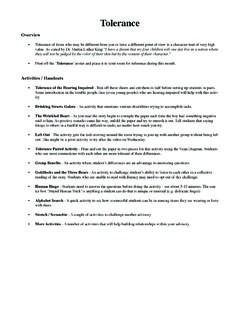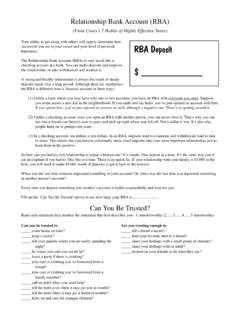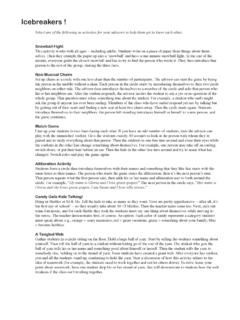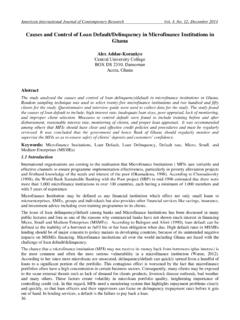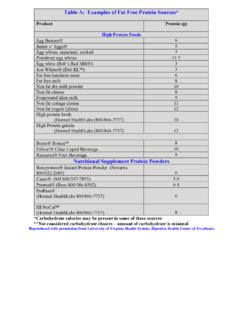Transcription of Icebreakers and Name Games - Minnesota Middle …
1 Icebreakers and name Games name Plate Activity Hand out a sheet of paper (construction paper is best). Fold the paper in half (5-1/2 x 8-1/2) and have students use a marker to print their name in the Middle . Then have them place something about them in each corner - for example - upper left corner a drawing of what they did this summer, lower left corner - print a word or two that best describes them (friendly, athletic, etc.), upper right corner a drawing of their fa- vorite hobby or activity, lower right corner - favorite movie. After students are done, then tell them to get in groups of three (some- times it is fun to have some music for this activity - as soon as the mu- sic begins they need to get into a group of three ). Stop the music - and have them share what they have drawn in one (or two) of the corners. After about 2-3 minutes start the music again and have them regroup into another - this time with different people.
2 Share what is in the other corners. After doing this a few times, have everyone sit down and select people to tell about what they learned about someone else in the room. Introduce Another Divide the class into pairs. Each person talks about him/herself to the other, sometimes with specific instructions to share a certain piece of information. For example, The one thing I am particularly proud of After five minutes, the participants introduce the other person to the rest of the class. Character Descriptions Have students write down one or two adjectives describing themselves. Put these on a stick-on badge. Have class members find someone with similar or opposite adjectives and talk for five minutes with the other person. I've Done Something you Haven't Done Have each person introduce themselves and then state something they have done that they think no one else in the class has done.
3 If someone else has done it, the students must state something else until he/she finds something that no one else has done. Find Someone Each person writes on a blank index card one to three statements, such as favorite color, interest, hobby, or vacations. Pass out cards so everyone gets someone else's card. Have that person find the person with their card and introduce themselves. Famous Person People write a famous name on a piece of paper and pin it on someone else's back. Person tries to guess what name is pinned on his/her back by asking others around the room yes or no questions. Variation: Use famous places instead of famous people. My name People introduce themselves and tell what they know about why they have their name (their mother wanted to name me after her great aunt Helen who once climbed Pike's Peak in high heels, etc.)
4 It could be the first, Middle , or nickname. How do you Feel? Ask the students to write down words or phrases that describe their feelings on the first day of class. List the responses on the blackboard. Then ask them to write down what they think you, as the teach- er, are feeling this first day of class. List them on the blackboard in a second column and note the parallels. Interview Three Words Assign each person in the group to another person from the group. Then have them find out as much of the following information about each other as they possibly can in 2-3 minutes; name , hobbies, family, state, school/job, favorite color, favorite food, favorite type of music, etc. They can interview back and forth or each person could be assigned to interview one person while a completely different person is interviewing them. Then have them use 3 words to describe their assigned partner, but 3.
5 Words only, (example: Joe Bob was my partner, funny, energetic, happy). Variable Names Choose one of the introductions below. Gather people around and give them the instructions and an example using your own name as an example. Tell the group that you will be passing to your (left or right) and then ask if there are any questions. People should have the right to pass if they can't think of an answer right away, just make sure to get back to them at the end to see if they have an answer. Everyone introduces him/herself as their favorite food. (I had to go around saying, Hello! I'm Sau- sage McMuffin with Egg! . Introduce yourself with your first name and an adjective that begins with the same first letter of your name . (Hi! I'm Nan. I'm feeling nutty today.). Interpersonal BINGO. Make up a BINGO style sheet with information in each square that may fit people in your group.)
6 (If you know the people, you can actually tailor the information to specifically fit your group). Use a diver- sity of information regarding hobbies, background experiences, cultural references, etc. ( , traveled more than 60 miles to get here; is an only child; didn't see (insert movie here);.. the possibilities are endless). People then play BINGO by meeting other people in the room, introducing themselves and getting prizes. Mute Line-up Participants are asked to line themselves up according to their date of birth (not year). For example, someone born on the 16th of January would be closer to the front than someone who was born on the 5th of May. The rules of the icebreaker are: Participants must not talk or use their mouth in any way. Use other categories (birth date, shoe size, bus number, etc.). Solemn and Silent The instructor explains that this exercise will take self-control.
7 Members pair back to back. On the count of three, everyone must face their partner, look each other in the eyes, and then try to remain solemn and serious. No speaking! The first to smile or laugh must sit down. All who remain standing then take a new partner and the activity continues until only one person has not smiled or laughed. (Second round of playing can involve two teams competing to outlast each other.) If you get a pair at the end who are both keeping a straight face, the rest of the group can act as hecklers to disrupt them. Meuume The basic aim of this activity is to learn the names of others in your group, without forgetting your own!!! Participants stand in a straight line. The first person in line ( , Jim) turns to the 2nd person ( , Penny) and follows the name process of Meuume as outlined: Jim says his own name : Jim Penny says her own name : Penny Jim says Penny's name : Penny Penny says Jim's name : Jim Jim then moves onto the 3rd person in the line, the 4th, and so on.
8 The 2nd person then addresses the 3rd person and so on. Continue until the last person in line has had their turn at introducing them- selves to each person in line. If you forget the order that the introductions are done, think of the name of the game: Meuume, or Me, You, You, Me. Truth or Pretend? Have each person tell one thing about themselves that is true and one thing that is false, without re- vealing which is which. Then have all participants try and guess which one is the truth. Toss-A- name -Game The objective of this activity is to gradually learn the names of all those in the group. This is achieved by first throwing a soft object (small soft objects, balls, or toys) around/across the circle, with each person saying their name when they catch the object. After a few minutes of this, as well as saying their own name , participants then also say the name of the person they choose to throw to.
9 Partici- pants cannot throw to the person directly beside them. Eventually, the game can be made more diffi- cult by throwing in more objects. Comic Strip Chaos Each participant takes a turn at picking a comic frame out of a large container. After the entire group has each chosen one, the participants begin to search for others with the same comic strip sequence. After the participants have found everyone in their group, they must arrange themselves so that the sequence of frames are in chronological order to form the comic strip correctly. Upon completion of sequence, the newly formed group sits down together. Great game to break large group into smaller groups.

